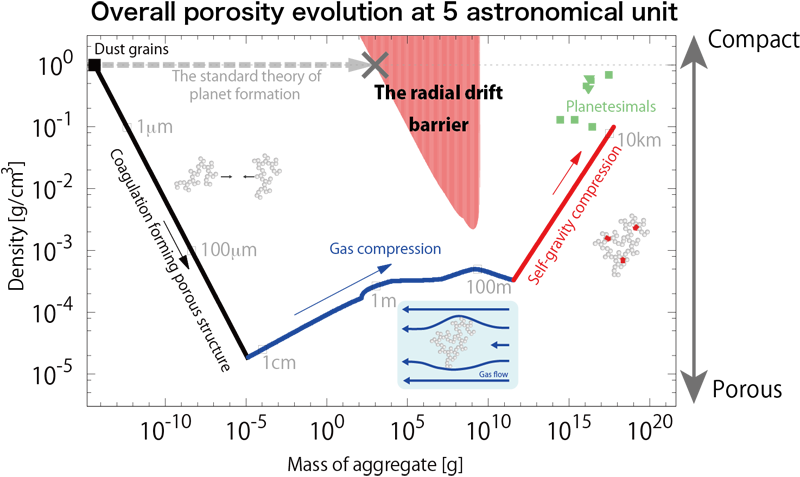
|
|
Figure.1: Artistic view of fluffy aggregates in a circumstellar disk. The high resolution figure is available here. Credit:SOKENDAI/NAOJ |
A Japanese research team led by Akimasa Kataoka (SOKENDAI / Theoretical Division of National Astronomical Observatory of Japan) has released a new scenario of planetesimal formation from micron-sized dust grains to 10 kilometer-sized planetesimals.
Planets are believed to form by coagulation of miron-sized dust grains. However, it was a long-standing mystery how dust grains grow to planets. Especially, the direct sticking from grains to planetesimals has been believed to be difficult because their gravitational interaction is weak. The research team challenged this "mystery from dust grains to planetesimals" by solving the internal structure evolution of fluffy dust aggregates.
The research team revealed that dust grains coagulate to form "the seeds of planets," which are fluffy dust aggregates. Then, the aggregates are compressed by pressure of the surrounding gas and their self-gravity to form planetesimals. Moreover, the Japanese astrophysicists found that the evolutional path of the seeds of planets solved the long-standing theoretical problem over 30 years in the planet formation theory, which is the radial drift problem.

|
|
Figure.1: Artistic view of fluffy aggregates in a circumstellar disk. The high resolution figure is available here. Credit:SOKENDAI/NAOJ |
| Akimasa Kataoka | (SOKENDAI / NAOJ / JSPS research fellow) |
| Hidekazu Tanaka | (Hokkaido University) |
| Satoshi Okuzumi | (Tokyo Institute of Technology) |
| Koji Wada | (Chiba Institute of Technology) |
This work has been published as two papers on the journal of "Astronomy & Astrophysics" on June and September, 2013. The both papers have been selected to highlighted papers of A&A.
"Static compression of porous dust aggregates", A.Kataoka, H.Tanaka, S.Okuzumi, and K.Wada A&A 554, A4
"Fluffy dust forms icy planetesimals by static compression", A.Kataoka, H.Tanaka, S.Okuzumi, and K.Wada, A&A 557, L4
In the standard planet formation theory, dust grains, micron-sized tiny particles, stick each other to form larger bodies in circumstellar disks, and yield to planets. However, three barriers have been proposed in the early stage of the planet formation theory. The first one is the radial drift problem; the meter-sized bodies in growing phase quickly fall onto the central star. The second is the fragmentation problem; dust grains collide too fast to stick, but disrupted. The last is the bouncing problem; dust grains collide and does not stick but bounce. Overcoming these barriers has been the most important issue in the early stage in the planet formation theory.
Both experimental and numerical studies have shown that dust grains form porous structure in coagulation. Such objects are called "aggregates." Astrophysicists have believed that the porous structure would be compressed by dust-dust collisions. However, the recent numerical studies have shown that the collisional compression is not enough effective to compress the porous structure, and thus the compact planetesimals, the seeds of planets, can not be formed. Therefore, astrophysicists are requested to consider another compression mechanisms to form planetesimals.
The Japanese research team introduces two other compression mechanisms; static compression by pressure of the disk gas and by the self-gravity of the aggregates themselves. By using numerical simulations, the team first obtain how much pressure is required to compress fluffy aggregates. Then, they applied the results to planet formation.
|
Movie:
A dust aggregate under compression in the computer simulation. One particle represents a 0.1 micron-sized icy particle. Download the movie. Credit: Akimasa Kataoka (SOKENDAI/NAOJ) |
As a result, the team succeeded to find a new scenario of overall porosity evolution of dust aggregates. When dust aggregates grow to 1 centimeter-sized bodies, the gas compression becomes effective before the collisional compression, which have been believed to be effective. Feeling the gas pressure, the aggregates grow to larger size. When they become as large as 100 meter-sized bodies, they are drastically compressed by their self-gravity, and then keep coagulating to form planetesimals.
This is a first coherent scenario of the growth theory from micron-sized dust grains to kilometer-sized planetsimlas.

|
|
Figure 2:
The overall porosity evolution of dust aggregates. The orbital radius is assumed to be 5 astronomical unit. The red shaded region represents the region where the aggregates fall onto the central star. The grey dotted line shows that the standard scenario fails to overcome the radial drift region. The pathway of fluffy aggregates, on the other hand, illustrates that the dust grains coagulate to form fluffy structure (black line), forming larger bodies feeling the gas compression (blue line) and the self-gravity (red line), then finally form compact planetesmals. The green dots represent the mass and density of the comets, which are believed to be remnants of the planetesimals. The expected mass and density are consistent with the comets. Download the high resolution figure. Credit:Akimasa Kataoka (SOKENDAI/NAOJ) |
The astrophysicist team also found that the newly proposed scenario solves the three main problems in the early stage of the planet formation scenario, if the aggregates consist of a number of icy particles. First, fluffy aggregates grow enough fast before falling onto the central star. Second, icy aggregates are sticky to overcome the fragmentation problem. Finally, pores of aggregates have shown to dissipate the collisional energy to prevent bouncing. On the other hand, rocky aggregates are not enough sticky to prevent fragmentation problem. The rocky planetesimal formation is still an open issue.